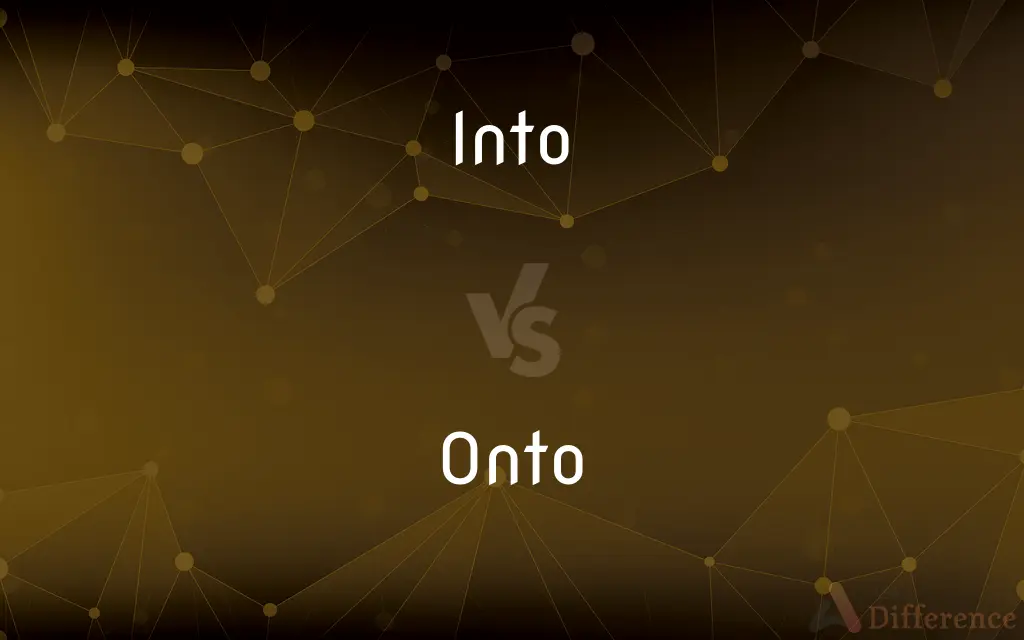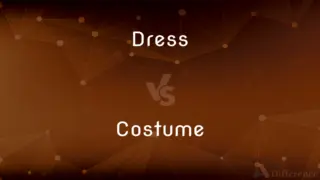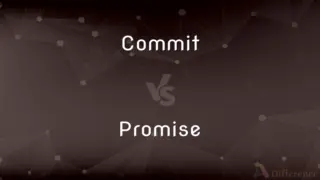Into vs. Onto — What's the Difference?
By Fiza Rafique & Urooj Arif — Updated on March 10, 2024
Into indicates movement towards the inside or inclusion within something, whereas onto suggests movement towards a surface or top.

Difference Between Into and Onto
Table of Contents
ADVERTISEMENT
Key Differences
Into is used to express movement or action with the aim of reaching the inside or interior of something. It conveys a sense of penetration, immersion, or entry, as in going into a room or delving into a topic. On the other hand, onto denotes movement towards or positioning on the top or surface of something, highlighting transition or elevation, such as stepping onto a platform or placing a book onto a shelf.
The preposition into is often associated with transitions or transformations, indicating a change in state or condition, like turning into something else or being incorporated into a group. Whereas, onto can imply a physical connection or contact, suggesting an action that results in one object being atop another, which may not necessarily involve a change in the state of the object being moved.
Into can also suggest involvement or participation within a context or activity, implying a sense of immersion or engagement, such as getting into a hobby or entering into a discussion. Conversely, onto is more about achieving a position or location, focusing on the action of moving or being placed on an external surface without implying deep engagement or immersion.
The use of into can denote a direction towards the interior part of a conceptual or physical space, suggesting depth, involvement, or thorough engagement, like diving into a book. Onto, however, emphasizes the action of moving upwards or towards a surface, often indicating a final position or resting place, such as climbing onto a roof.
In some contexts, into is used to express figurative transitions, like falling into despair, where the emphasis is on an emotional or metaphorical entry into a state or condition. Onto, in contrast, is less likely to be used figuratively and is more often associated with literal physical movements or placements, reflecting a straightforward transition from one position to another, such as jumping onto a bed.
ADVERTISEMENT
Comparison Chart
Basic Use
Indicates movement towards an interior or within something
Suggests movement towards or positioning on a surface
Implied Action
Entry, penetration, or immersion
Placement, elevation, or transition to a surface
Association
Transition, transformation, or deep involvement
Physical connection, achievement of position
Contexts
Often used with abstract concepts or physical spaces
Primarily used with physical movements or placements
Figurative Use
Common in expressing emotional or metaphorical transitions
Less common, usually denotes literal physical actions
Compare with Definitions
Into
Figurative entry.
Falling into a routine can be comforting.
Onto
Achieving position.
He climbed onto the roof to retrieve the ball.
Into
Transformation or change.
Water turns into ice at 0°C.
Onto
Direct transition.
She moved onto the next topic smoothly.
Into
Movement towards the inside.
She walked into the room.
Onto
Movement to a surface.
The cat jumped onto the windowsill.
Into
Involvement or participation.
He's really into classical music.
Onto
Literal placement.
Place the vase onto the table carefully.
Into
Engaging deeply.
She dove into her studies.
Onto
Gaining elevation.
They stepped onto the stage with confidence.
Into
To the inside or interior of
Went into the house.
Onto
Of, relating to, or being a function such that every element of the codomain is the value that corresponds to an element in the domain.
Into
To the activity or occupation of
Recent college graduates who go into banking.
Onto
On top of; to a position on; upon
The dog jumped onto the chair.
Into
To the condition, state, or form of
Dishes breaking into pieces.
Changed into a butterfly.
Onto
(Informal) Fully aware of; informed about
The police are onto the robbers' plans.
Into
So as to be in or be included in
Parties entering into an agreement.
Wrote a new character into the play.
Onto
Arriving upon or on top of (speaking of a physical or metaphorical movement).
My cat just jumped onto the keyboard.
Into
(Informal) Interested in or involved with
They are into vegetarianism.
Onto
(informal) Aware of.
The thought-police were onto my plans of world domination.
Into
To a point within the limits of a period of time or extent of space
Well into the week.
Onto
(mathematics) Being an onto function with a codomain of (see below).
The exponential function maps the set of real numbers onto the set of positive real numbers.
Into
In the direction of; toward
Looked into the distance.
Pointed into the sky.
Onto
Assuming each of the values in its codomain; having its range equal to its codomain.
Considered as a function on the real numbers, the exponential function is not onto.
Into
Against
Crashed into a tree.
Into
As a divisor of
The number 3 goes into 9 three times.
Into
To or towards the inside of.
Mary danced into the house.
Pour the wine into the decanter.
The nomads shave intricate designs into their camels' fur.
Into
To or towards the region of.
We left the house and walked into the street.
The eagle flew off into the wide blue sky.
Into
Against, especially with force or violence.
The car crashed into the tree.
I wasn't careful, and walked into a wall.
Into
Indicates transition into another form or substance.
I carved the piece of driftwood into a sculpture of a whale.
Right before our eyes, Jake turned into a wolf!
Into
Indicates division or the creation of subgroups or sections.
A cow's stomach is divided into four chambers.
Into
After the start of.
About 20 minutes into the flight, the pilot reported a fire on board.
Into
(colloquial) Interested in or attracted to.
She's really into Shakespeare right now.
My date for tonight has black hair, and I'm into that.
Into
Expressing the operation of multiplication.
Five into three is fifteen.
Into
(mathematics) Expressing the operation of division, with the denominator given first. Usually with "goes".
Three into two won't go.
24 goes into 48 how many times?
Into
Investigating the subject (of).
There have been calls for research into the pesticides that are blamed for the decline in bee populations.
Into
To the inside of; within. It is used in a variety of applications.
Into
Expressing entrance, or a passing from the outside of a thing to its interior parts; - following verbs expressing motion; as, come into the house; go into the church; one stream falls or runs into another; water enters into the fine vessels of plants.
Into
Expressing penetration beyond the outside or surface, or access to the inside, or contents; as, to look into a letter or book; to look into an apartment.
Into
Indicating insertion; as, to infuse more spirit or animation into a composition.
Into
Denoting inclusion; as, put these ideas into other words.
Into
Indicating the passing of a thing from one form, condition, or state to another; as, compound substances may be resolved into others which are more simple; ice is convertible into water, and water into vapor; men are more easily drawn than forced into compliance; we may reduce many distinct substances into one mass; men are led by evidence into belief of truth, and are often enticed into the commission of crimes; she burst into tears; children are sometimes frightened into fits; all persons are liable to be seduced into error and folly.
Common Curiosities
Is "onto" only used for physical movements?
Primarily, yes, "onto" is mostly used for describing physical movements or placements.
Does "into" imply a deeper engagement than "onto"?
Yes, "into" often implies deeper engagement or immersion, whereas "onto" focuses on surface placement.
Can "into" and "onto" be used interchangeably?
No, "into" and "onto" are not interchangeable as they convey different spatial relationships.
What does "into" signify?
"Into" signifies movement towards or within the interior of something, or a transition into a new state.
Can "onto" denote a final position?
Yes, "onto" often denotes a final position or placement on a surface.
How is "onto" used?
"Onto" is used to indicate movement towards or on top of a surface, often implying elevation or placement.
Can "onto" imply a direct action?
Yes, "onto" implies a direct action of moving or placing something on a surface.
How does "onto" relate to elevation?
"Onto" suggests movement that results in being on an elevated surface or position.
Is "into" used for abstract concepts?
Yes, "into" is commonly used with abstract concepts to describe involvement or engagement.
Is "into" appropriate for describing emotional states?
Yes, "into" can be used to describe entering into emotional states or conditions.
What kind of transitions does "into" describe?
"Into" can describe both physical and metaphorical transitions, including changes in state or involvement in activities.
Can "into" describe transformations?
Yes, "into" is often used to indicate transformations or changes from one state to another.
What is the difference in figurative usage between "into" and "onto"?
"Into" has more figurative uses, expressing transitions in state or emotion, while "onto" is less commonly used figuratively.
How do "into" and "onto" differ in spatial context?
"Into" relates to interiors and inclusion within spaces, whereas "onto" relates to surfaces and top positions.
How do the prepositions affect the meaning of actions?
The choice between "into" and "onto" affects the perceived direction, depth, and nature of actions or transitions.
Share Your Discovery

Previous Comparison
Dress vs. Costume
Next Comparison
Commit vs. PromiseAuthor Spotlight
Written by
Fiza RafiqueFiza Rafique is a skilled content writer at AskDifference.com, where she meticulously refines and enhances written pieces. Drawing from her vast editorial expertise, Fiza ensures clarity, accuracy, and precision in every article. Passionate about language, she continually seeks to elevate the quality of content for readers worldwide.
Co-written by
Urooj ArifUrooj is a skilled content writer at Ask Difference, known for her exceptional ability to simplify complex topics into engaging and informative content. With a passion for research and a flair for clear, concise writing, she consistently delivers articles that resonate with our diverse audience.














































